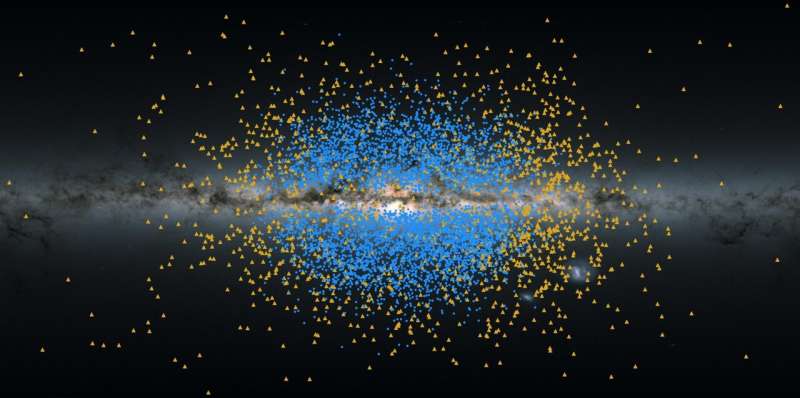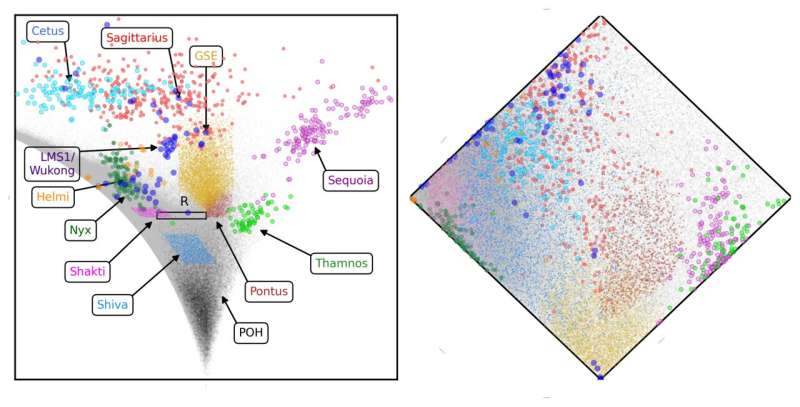This article has been reviewed according to Science X's editorial process and policies. Editors have highlighted the following attributes while ensuring the content's credibility:
fact-checked
trusted source
proofread
Gaia unravels the ancient threads of the Milky Way

ESA's Gaia space telescope has further disentangled the history of our galaxy, discovering two surprising streams of stars that formed and wove together more than 12 billion years ago.
The two streams, named Shakti and Shiva, helped form the infant Milky Way. Both are so ancient they likely formed before even the oldest parts of our present-day galaxy's spiral arms and disk.
"What's truly amazing is that we can detect these ancient structures at all," says Khyati Malhan of the Max Planck Institute for Astronomy (MPIA) in Heidelberg, Germany, who led the research. "The Milky Way has changed so significantly since these stars were born that we wouldn't expect to recognize them so clearly as a group—but the unprecedented data we're getting from Gaia made it possible."
Using Gaia observations, the researchers were able to determine the orbits of individual stars in the Milky Way, along with their content and composition. "When we visualized the orbits of all these stars, two new structures stood out from the rest among stars of a certain chemical composition," adds Khyati. "We named them Shakti and Shiva." The work is published in The Astrophysical Journal.
Truly ancient fragments
Each stream contains the mass of about 10 million suns, with stars of 12 to 13 billion years in age all moving in very similar orbits with similar compositions. The way they're distributed suggests that they may have formed as distinct fragments that merged with the Milky Way early in its life.
Both streams lie towards the Milky Way's heart. Gaia explored this part of the Milky Way in 2022 using a kind of "galactic archaeology"; this showed the region to be filled with the oldest stars in the entire galaxy, all born before the disk of the Milky Way had even properly formed.
"The stars there are so ancient that they lack many of the heavier metal elements created later in the universe's lifetime. These heavy metals are those forged within stars and scattered through space when they die. The stars in our galaxy's heart are metal-poor, so we dubbed this region the Milky Way's 'poor old heart,'" says co-author Hans-Walter Rix, also of MPIA and the lead "galactic archaeologist" from the 2022 work.
"Until now, we had only recognized these very early fragments that came together to form the Milky Way's ancient heart. With Shakti and Shiva, we now see the first pieces that seem comparably old but located further out. These signify the first steps of our galaxy's growth towards its present size."
A complex family tree
While very similar, the two streams are not identical. Shakti stars orbit a little further from the Milky Way's center and in more circular orbits than Shiva stars. Fittingly, the streams are named after a divine couple from Hindu philosophy who unite to create the universe (or macrocosm).
Some 12 billion years ago, the Milky Way looked very different to the orderly spiral we see today. We think that our galaxy formed as multiple long, irregular filaments of gas and dust coalesced, all forming stars and wrapping together to spark the birth of our galaxy as we know it. It seems that Shaki and Shiva are two of these components—and future Gaia data releases may reveal more.
Khyati and Hans-Walter also built a dynamical map of other known components that have played a role in our galaxy's formation and were discovered using Gaia data. These include Gaia-Sausage-Enceladus, LMS1/Wukong, Arjuna/Sequoia/I'itoi, and Pontus. These star groups all form part of the Milky Way's complex family tree, something that Gaia has worked to build over the past decade.

"Revealing more about our galaxy's infancy is one of Gaia's goals, and it's certainly achieving it," says Timo Prusti, Project Scientist for Gaia at ESA. "We need to pinpoint the subtle yet crucial differences between stars in the Milky Way to understand how our galaxy formed and evolved.
"This requires incredibly precise data—and now, thanks to Gaia, we have that data. As we discover surprise parts of our galaxy like the Shiva and Shakti streams, we're filling the gaps and painting a fuller picture of not only our current home, but our earliest cosmic history."
More information: Khyati Malhan et al, Shiva and Shakti: Presumed Proto-Galactic Fragments in the Inner Milky Way, The Astrophysical Journal (2024). DOI: 10.3847/1538-4357/ad1885
Provided by European Space Agency





















